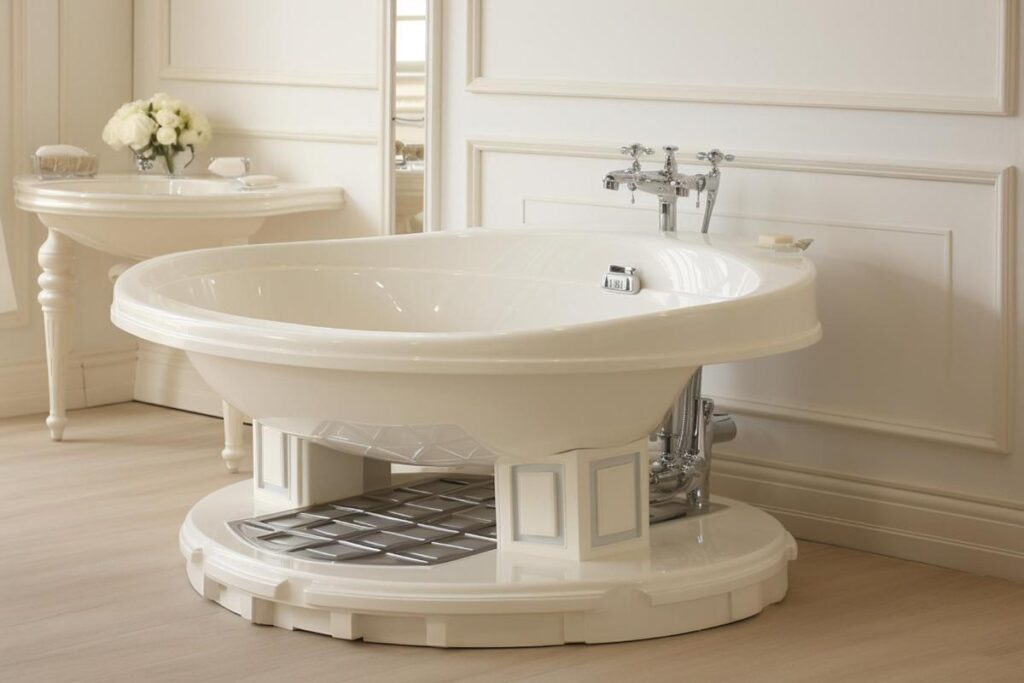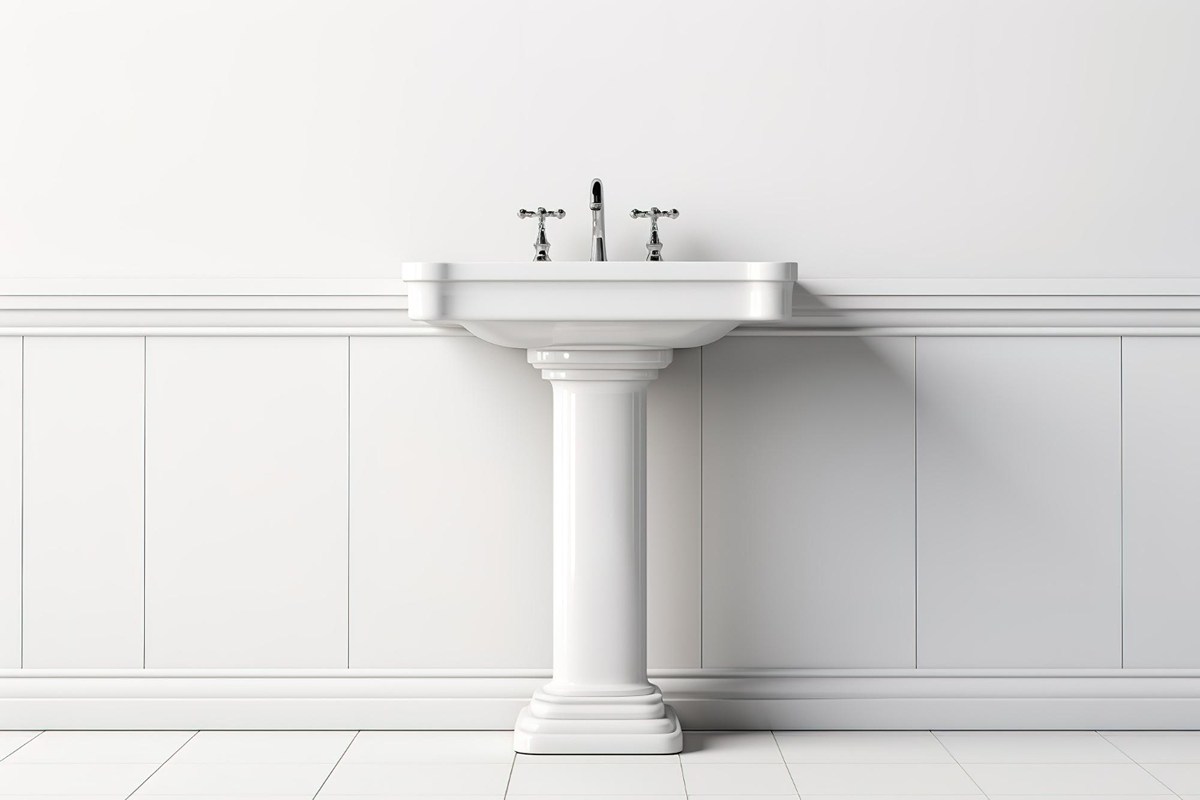A vintage antique pedestal sink is a timeless bathroom fixture that brings elegance, charm, and history into your home. Once a staple in early 1900s bathrooms, these sinks are now making a stylish comeback in classic and farmhouse-inspired interiors. Their simple yet graceful design makes them a favorite for those who love mixing old-world beauty with modern comfort. In this guide, you’ll learn how to identify an authentic vintage pedestal sink, choose the right style for your space, and take care of it properly. Let’s explore why this historic sink might be the perfect centerpiece for your bathroom.
What Is a Vintage Antique Pedestal Sink?
A vintage antique pedestal sink is a freestanding bathroom sink that stands on a single leg, or pedestal, and reflects styles from the late 1800s to the early 1900s. These sinks were commonly made of cast iron, porcelain, or vitreous china and were popular in homes before built-in vanities became common.
What Makes a Sink “Vintage” or “Antique”?
- Antique sinks are typically over 100 years old and are original pieces from the early 20th century or earlier.
- Vintage sinks are generally 20 to 99 years old but still retain the old-world design and charm.
- Vintage-inspired sinks are newly made but styled to look like antiques. These offer modern plumbing compatibility while keeping a classic look.
A Quick History Timeline:
- Late 19th Century: Pedestal sinks became popular during the Victorian era, known for ornate designs and fine detailing.
- Early 20th Century: Art Deco and early industrial styles influenced simpler, cleaner sink designs.
- Mid-20th Century Onward: Built-in cabinets replaced pedestal sinks, but vintage versions remained prized for their style.
Benefits of Using a Vintage Antique Pedestal Sink
Choosing a vintage antique pedestal sink isn’t just about style—it’s about bringing history, charm, and function into your bathroom. These sinks offer more than just a place to wash your hands—they tell a story, save space, and last for decades.
Whether you’re restoring an old home or adding character to a modern one, here are the key benefits:
Why Choose a Vintage Pedestal Sink?
- Adds elegance and personality to your bathroom, giving it a unique, classic feel.
- Perfect for small bathrooms, thanks to its slim, freestanding design that opens up floor space.
- Crafted with quality materials like porcelain or cast iron that stand the test of time.
More Reasons to Love It:
- Timeless aesthetics that never go out of style
- Eco-friendly choice – reusing vintage sinks reduces waste
- Blends beautifully with vintage, farmhouse, or traditional interiors
Vintage Antique Pedestal Sink Identification
Identifying a vintage antique pedestal sink can be a rewarding process for collectors or homeowners looking to restore an old fixture. Knowing how to spot an authentic piece can help you avoid replicas and ensure you’re getting a genuine antique.
How to Identify a True Antique Pedestal Sink
Check for Manufacturer Stamps or Labels: Many genuine antique sinks have a stamp or manufacturer label, often located on the back or underside. Look for names like Kohler, Standard, or American Standard, which were popular during the early to mid-20th century.
Look for Age Marks: The material can reveal a lot. Antique sinks usually have visible wear patterns, glaze cracking, or patina that modern reproductions lack. Check for subtle signs of aging, such as slight discoloration or wear around the edges.
Common Materials Found in Vintage Sinks
- Porcelain: Known for its glossy finish and durability, porcelain was a popular material for vintage sinks.
- Vitreous China: Similar to porcelain but more resistant to stains and moisture.
- Cast Iron: Often coated with enamel, cast iron was used for its strength and long-lasting quality.
Typical Features of Antique Pedestal Sinks
- Fluted Pedestal: Often found in Victorian designs, these pedestals feature vertical grooves for added texture.
- Curved Bowl: Unlike modern squared-off sinks, antique models often have gently rounded bowls.
- Exposed Plumbing: Many vintage pedestal sinks showcase their plumbing, adding to the old-world charm.
Table: Quick Identification Guide
| Feature | Description |
| Material | Porcelain, Cast Iron |
| Period | 1900s–1950s |
| Styles | Art Deco, Victorian, Edwardian |
Popular Styles and Designs

When choosing a vintage antique pedestal sink, understanding the different styles can help you select one that fits your bathroom’s aesthetic. From intricate Victorian designs to sleek Art Deco and mid-century modern styles, there’s a perfect option for every taste.
Victorian Pedestal Sinks
Victorian pedestal sinks are some of the most ornate and detailed sinks from the late 19th to early 20th century. These sinks often feature:
- Intricate carvings or fluted pedestals.
- Elaborate faucets with delicate details.
- Soft, rounded bowl shapes for a more traditional look.
Victorian sinks bring a sense of grandeur and luxury to any bathroom, making them perfect for homes with a vintage or classic design.
Art Deco and Mid-Century Modern Styles
As we moved into the 1920s and beyond, design aesthetics shifted. Art Deco and mid-century modern pedestal sinks embraced cleaner lines, geometric shapes, and streamlined designs:
- Art Deco: Characterized by bold geometric patterns, angular shapes, and metallic finishes. These sinks offer a more glamorous, luxurious appeal.
- Mid-Century Modern: Known for their minimalist design, clean lines, and functional shapes, mid-century sinks are often made with durable materials like porcelain and enamel.
Wall-Mounted Hybrids
For a more contemporary twist on the traditional pedestal sink, wall-mounted hybrid sinks combine the elegance of a pedestal with the sleek look of a wall-mounted fixture. These sinks are mounted to the wall but rest on a simple pedestal base, providing:
- Space-saving design with a floating appearance.
- Sleek, minimalist look that works well in modern or smaller bathrooms.
- Easy maintenance as there are fewer crevices for dirt to collect.
How to Choose the Right Vintage Pedestal Sink
Choosing the perfect vintage pedestal sink for your bathroom requires more than just picking a beautiful design. You need to consider the size of your bathroom, the style of your décor, and whether the sink will fit with your plumbing. Here’s a guide to help you make the best decision for your space.
Consider Bathroom Size
One of the first things to keep in mind when choosing a vintage pedestal sink is your bathroom’s size. These sinks work wonderfully in small bathrooms due to their compact, space-saving design. However, if you have a larger bathroom, you might prefer a bigger pedestal sink or one with additional storage features.
- For small bathrooms: Opt for a retro pedestal sink with a slim pedestal to maximize space.
- For larger bathrooms: Choose a more ornate design, like a classic porcelain basin, that can make a bold statement while still being practical.
Match Style with Décor (Modern vs. Traditional)
It’s important to match your vintage pedestal sink with your bathroom’s overall décor. Whether your bathroom features modern, traditional, or old-fashioned elements, there’s a perfect style to match:
- Modern décor: If you prefer clean, contemporary lines, a retro pedestal sink or mid-century modern style will complement your modern design.
- Traditional or vintage décor: A more intricate antique wash basin with a Victorian or Art Deco style will enhance the timeless elegance of your bathroom.
Check Plumbing Compatibility
Before choosing your vintage pedestal sink, make sure it’s compatible with your existing plumbing. Many antique sinks require specific plumbing setups. It’s crucial to ensure that the sink’s drain and water connections are compatible with your bathroom’s plumbing system.
If you’re restoring a vintage sink, you may need an adapter to make it work with modern plumbing.
Wall-mounted hybrids may need additional support for the plumbing and drainage connections.
Where to Find Real Vintage Pedestal Sinks
If you’re looking to add a vintage antique pedestal sink to your bathroom, there are several places where you can find authentic pieces. Whether you’re after an antique wash basin or a retro pedestal sink, here’s where to start your search for the perfect vintage piece.
Antique Stores and Salvage Yards
One of the best places to find genuine vintage pedestal sinks is at antique stores and salvage yards. These locations often specialize in preserving and selling older bathroom fixtures that are no longer in production. Here, you can find everything from classic porcelain basins to rare Victorian or Art Deco models.
- Pros: Hands-on inspection of the sink’s condition, ability to negotiate prices.
- Cons: Limited selection, may require restoration.
Online Marketplaces (eBay, Etsy, 1stDibs)
For more convenience, online marketplaces like eBay, Etsy, and 1stDibs offer a wide range of vintage pedestal sinks. These platforms have an abundance of sellers offering both authentic antique wash basins and vintage-inspired designs. Plus, online shopping allows you to compare prices and find unique pieces from around the world.
- eBay: Great for finding deals, but be cautious of sink conditions.
- Etsy: Focuses on handmade and vintage items, often with a modern twist on antique designs.
- 1stDibs: Specializes in high-end, rare antiques, often with verified authenticity.
Specialty Retailers
If you prefer shopping from a trusted source, specialty retailers often carry vintage-inspired or antique-style sinks. These stores may offer both reproduction vintage pedestal sinks and real antiques, along with expert advice on installation and maintenance. For example, you can find a curated selection of sinks at [Your Store’s Category Page], where we offer top-quality vintage pedestal sinks for all types of bathroom designs.
- Pros: Expert advice, warranty on products.
- Cons: Typically higher prices due to curation and quality control.
How to Restore or Refinish a Vintage Pedestal Sink
Restoring or refinishing a vintage antique pedestal sink can breathe new life into an older piece, allowing it to shine again in your bathroom. Whether it’s chipped porcelain, vintage plumbing issues, or simple cleaning, the right techniques can bring your sink back to its original beauty. Here’s how to restore and care for your vintage sink.
Re-glazing Chipped Porcelain
Over time, porcelain surfaces can develop chips or cracks. Re-glazing is an effective way to restore the original smoothness and finish of your vintage pedestal sink.
- Step 1: Clean the sink thoroughly to remove any dirt or grime.
- Step 2: Apply a porcelain repair kit, following the manufacturer’s instructions.
- Step 3: Re-glaze the area by applying a fresh coating of porcelain glaze to the chipped area, ensuring smooth and even coverage.
Fixing Vintage Plumbing Issues
Many vintage pedestal sinks may have outdated or damaged plumbing components. Here’s how to address common issues:
Check for leaks: Examine the sink’s drain and water supply connections. Leaks are often caused by worn-out seals or old gaskets.
Replace outdated plumbing: If the plumbing is too old to function properly, consider replacing components like the drain, faucet, and water lines with modern parts that still match the sink’s vintage look.
Cleaning Methods (Non-Abrasive Cleaners Only)
Proper care and cleaning are essential for maintaining your vintage pedestal sink. Always use non-abrasive cleaners to protect the sink’s delicate surface. Harsh chemicals and abrasives can scratch or damage the finish, diminishing its beauty.
- Step 1: Use a mild dish soap and warm water to clean your sink.
- Step 2: For tough stains, opt for a non-abrasive cleaner like a baking soda paste (mix baking soda with water) for gentle scrubbing.
- Step 3: Rinse thoroughly with clean water and wipe dry with a soft cloth to avoid water spots.
Pro Tip Box:
Use baking soda and vinegar for safe cleaning.
Mix baking soda with a little vinegar to create a natural, non-toxic cleaner that’s perfect for your vintage sink. Apply gently with a soft cloth, rinse thoroughly, and buff to restore shine.
Caring for Your Antique Pedestal Sink

Taking proper care of your vintage antique pedestal sink is essential to maintain its beauty and longevity. Whether it’s cleaning, preventing damage, or ensuring the plumbing is in good condition, a little attention goes a long way. Here’s how you can properly care for your classic porcelain basin and keep it looking pristine.
Regular Cleaning
Regular cleaning is crucial to keep your vintage pedestal sink in top shape. Dirt, soap scum, and mineral deposits can accumulate over time, dulling the finish. To prevent this:
- Clean frequently: Use a mild, non-abrasive cleaner to remove stains and prevent buildup.
- Use a soft cloth or sponge: Avoid abrasive sponges or scrubbing brushes, as they can scratch the surface.
- Dry after cleaning: Wipe the sink dry with a soft towel to avoid water spots and prevent the growth of mold or mildew.
Avoid Using Harsh Chemicals
While it may be tempting to use heavy-duty cleaners, harsh chemicals can cause long-term damage to your vintage pedestal sink. They can strip away the protective glaze and leave behind stains or discoloration. Stick to gentle, non-toxic cleaning solutions like mild dish soap and warm water. For stubborn stains, try natural cleaners like baking soda and vinegar (as mentioned earlier).
- Avoid bleach: It can be too abrasive for your sink and may discolor the surface.
- Steer clear of abrasive scrubbing pads: These can scratch the surface and damage the finish over time.
Check for Cracks and Plumbing Leaks
Older vintage sinks are more prone to cracks and plumbing issues due to wear and tear. It’s important to regularly inspect your antique wash basin for signs of damage or leaks. Here’s what to look for:
- Cracks or chips in the porcelain: Check the surface carefully, especially around the edges and the drain area.
- Plumbing leaks: Look under the sink for any signs of leaking pipes, corrosion, or outdated plumbing that may need attention.
- Check the drain: Ensure the drainage system is functioning properly without any blockages.
Mistakes to Avoid When Buying a Vintage Sink
Choosing the perfect vintage antique pedestal sink can transform your bathroom—but if you’re not careful, you could end up with regrets. Here are some common mistakes people make when shopping for an antique wash basin, and how to avoid them.
Buying Without Proper Measurements
One of the most frequent errors is buying a retro pedestal sink without measuring your bathroom space. Vintage sinks can be bulky or oddly shaped, especially older models from the early 1900s.
Always measure:
- The width and depth of the sink.
- The height of the pedestal.
- The available space in your bathroom, especially if it’s a small or narrow layout.
Ignoring Cracks or Heavy Staining
While a little wear adds charm, significant damage can affect function and appearance.
Avoid sinks that show:
- Deep cracks in the porcelain (which may worsen over time).
- Heavy staining that doesn’t come off with gentle cleaning.
- Rust or corrosion around plumbing connections.
Not Checking Return Policy When Buying Online
When shopping on platforms like eBay, Etsy, or antique marketplaces, it’s easy to fall in love with a sink’s look. But what if it arrives damaged—or simply doesn’t fit?
Protect yourself:
- Always read the return policy carefully.
- Check seller reviews for trustworthiness.
- Ask for detailed photos and dimensions before purchasing.
Modern Reproductions vs. True Antiques
When looking for a vintage antique pedestal sink, you’ll often come across two main options: true antiques and modern reproductions. Each has its own set of benefits and drawbacks. Understanding the difference can help you make a smarter choice for your bathroom.
True Antique Sinks
Pros:
- Authentic charm and craftsmanship
- Unique details and rare designs
Cons:
- May require restoration or plumbing adjustments
- Harder to find in perfect condition
- Usually more fragile than new models
Modern Reproductions
These are new sinks designed to look like old-fashioned bathroom sinks, often replicating styles from the early 1900s.
Pros:
- Compatible with modern plumbing systems
- Often made with updated, durable materials
- Easier to install and maintain
Cons:
- Lack the historical authenticity of true antiques
- Some may look too “new” or factory-made
- Less valuable in terms of collectible wort
Cost Comparison
| Sink Type | Average Cost | Extra Expenses |
| True Antique | $300 – $1,200+ | Restoration, custom plumbing parts |
| Reproduction | $250 – $800 | Usually plug-and-play installation |
Style Authenticity vs. Modern Features
True antique pedestal sinks offer unmatched style and authenticity—perfect for collectors or historic home renovations. However, modern reproductions often come with updated features like overflow drains or ceramic coatings that resist stains better.
Conclusion
A vintage antique pedestal sink is more than just a bathroom fixture—it’s a statement piece full of charm, history, and elegance. Whether you choose a true antique or a well-made reproduction, these sinks can instantly elevate the look of your bathroom with their timeless beauty.
From their durable craftsmanship to their space-saving design, vintage pedestal sinks blend practicality with classic style. By understanding how to identify, restore, and care for one, you’ll not only preserve a piece of the past but also enhance your living space in a meaningful way.










